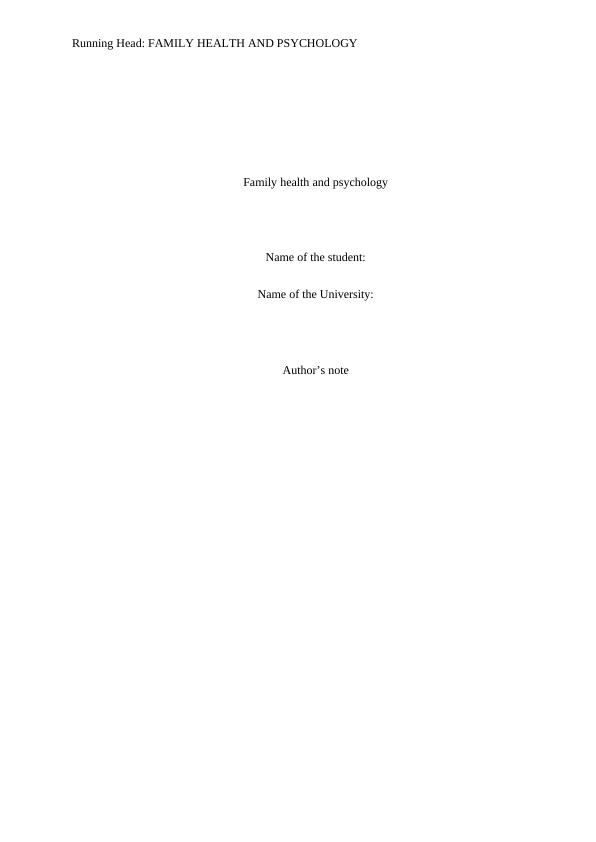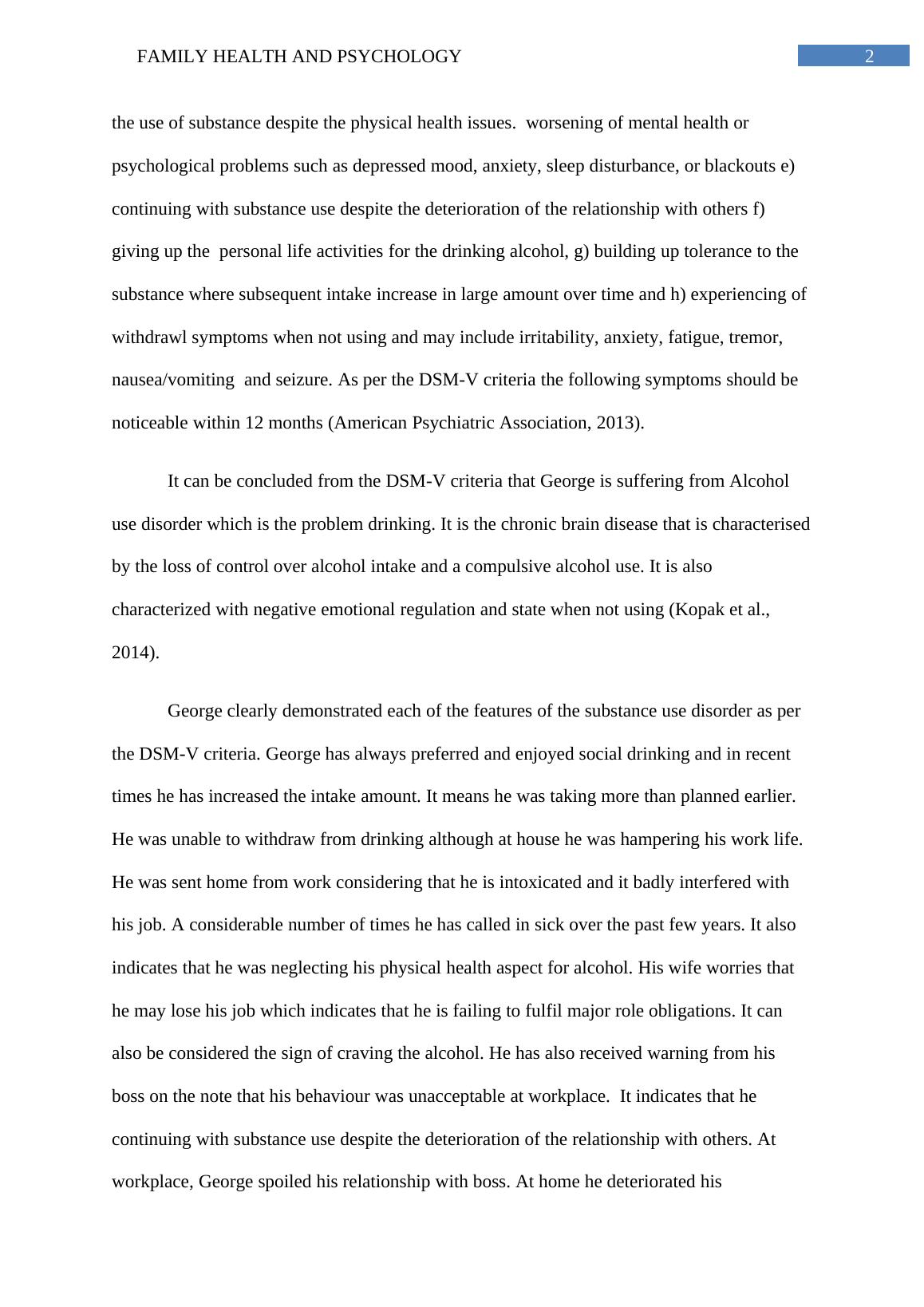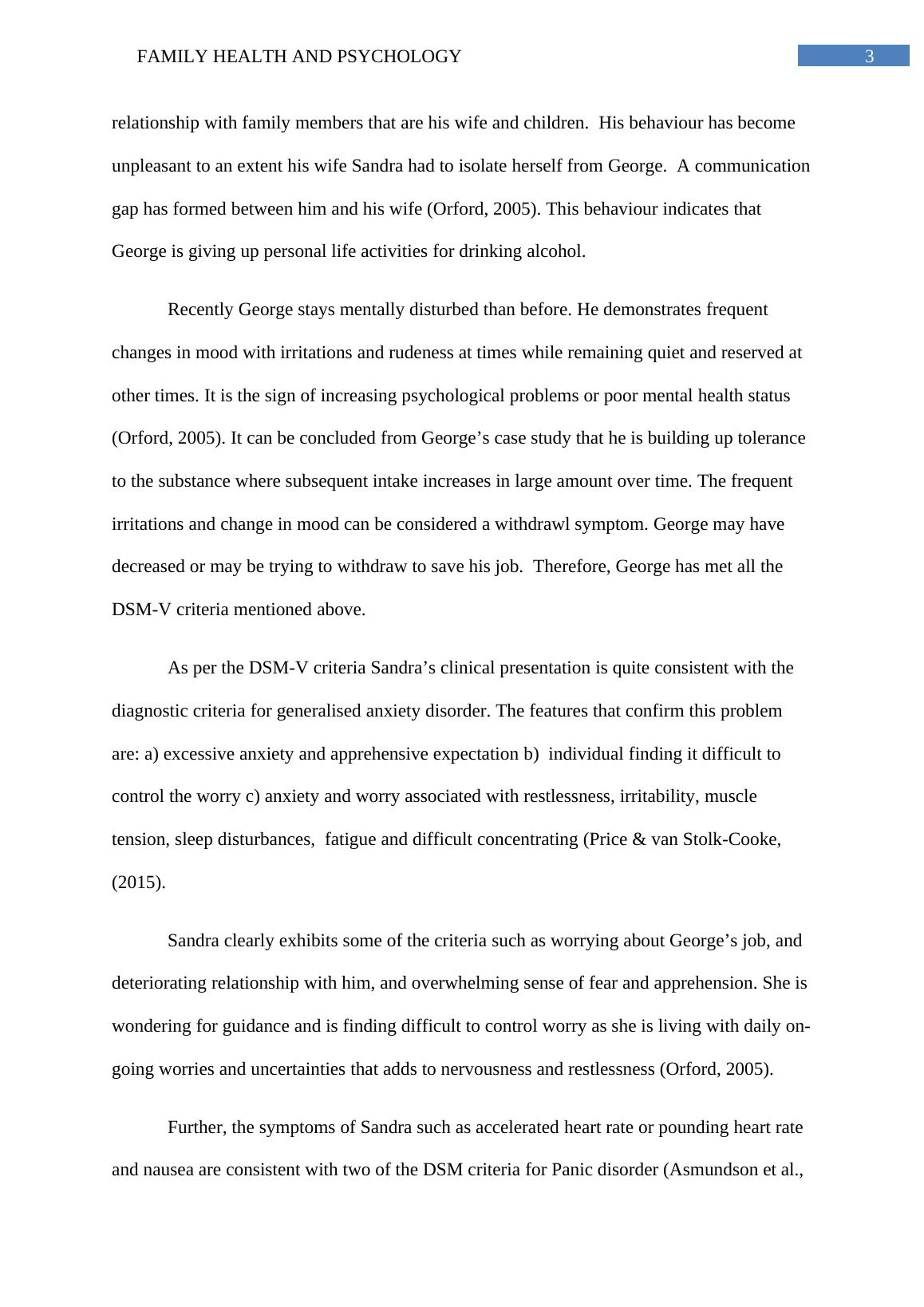PSYC 474 - Family Health and Psychology - Case Study
Added on 2020-03-01
13 Pages3637 Words67 Views
Running Head: FAMILY HEALTH AND PSYCHOLOGYFamily health and psychologyName of the student:Name of the University:Author’s note

1FAMILY HEALTH AND PSYCHOLOGYCASE-1 - The management of excessive drinking and drug taking on the familyIntroductionThe assignment deals with the case study of Georg, 42 years old man having wife andthree children. The case study describes the problem of excessive drinking by George and its impact on his family. In response to the case study the assignment outlines the diagnosis of the mental health issue(s)/disorder(s) of the family member(s) as highlighted in the case. The diagnosis is made in reference to the DSM-V criteria. It is the “Diagnostic and Statistical Manual of Mental Disorders”fifth edition (DSM-5). It is the latest version of the “American Psychiatric Association’s old-standard text” on the names, symptoms, and diagnostic featuresof every recognized mental illness—including addictions (Clarke et al., 2014). In the paper the rationale for every diagnosis is also given in reference to the information given in the case study. The paper then presents the case formulation where the particular features of the case study are related with contemporary literature. It means the problem faced by George and his diagnosis is discussed in reference to relevant theories and research in the area of substance disorder. Lastly, the assignment presents the treatment goals and planning for George. Based on the overall discussion the conclusion is drawn summarising all the points. DSM-V DiagnosisAs per the given case study the clinical presentation of George is quite consistent withthe DSM-V definition of disorder due to substance use. It defines the substance use (which inthis case is alcohol) disorder as problematic pattern of taking alcohol that impairs the daily life or results in distress at noticeable level (Hasin et al., 2013). The features mentioned by this manual are- a) consumption of more alcohol then usually planned, b) substance use resulting in failure to fulfil the major role obligations, c) craving for substance d) continuing

2FAMILY HEALTH AND PSYCHOLOGYthe use of substance despite the physical health issues. worsening of mental health or psychological problems such as depressed mood, anxiety, sleep disturbance, or blackouts e) continuing with substance use despite the deterioration of the relationship with others f) giving up the personal life activities for the drinking alcohol, g) building up tolerance to the substance where subsequent intake increase in large amount over time and h) experiencing of withdrawl symptoms when not using and may include irritability, anxiety, fatigue, tremor, nausea/vomiting and seizure. As per the DSM-V criteria the following symptoms should be noticeable within 12 months (American Psychiatric Association, 2013). It can be concluded from the DSM-V criteria that George is suffering from Alcohol use disorder which is the problem drinking. It is the chronic brain disease that is characterisedby the loss of control over alcohol intake and a compulsive alcohol use. It is also characterized with negative emotional regulation and state when not using (Kopak et al., 2014). George clearly demonstrated each of the features of the substance use disorder as per the DSM-V criteria. George has always preferred and enjoyed social drinking and in recent times he has increased the intake amount. It means he was taking more than planned earlier. He was unable to withdraw from drinking although at house he was hampering his work life. He was sent home from work considering that he is intoxicated and it badly interfered with his job. A considerable number of times he has called in sick over the past few years. It also indicates that he was neglecting his physical health aspect for alcohol. His wife worries that he may lose his job which indicates that he is failing to fulfil major role obligations. It can also be considered the sign of craving the alcohol. He has also received warning from his boss on the note that his behaviour was unacceptable at workplace. It indicates that he continuing with substance use despite the deterioration of the relationship with others. At workplace, George spoiled his relationship with boss. At home he deteriorated his

3FAMILY HEALTH AND PSYCHOLOGYrelationship with family members that are his wife and children. His behaviour has become unpleasant to an extent his wife Sandra had to isolate herself from George. A communicationgap has formed between him and his wife (Orford, 2005). This behaviour indicates that George is giving up personal life activities for drinking alcohol. Recently George stays mentally disturbed than before. He demonstrates frequent changes in mood with irritations and rudeness at times while remaining quiet and reserved at other times. It is the sign of increasing psychological problems or poor mental health status (Orford, 2005). It can be concluded from George’s case study that he is building up tolerance to the substance where subsequent intake increases in large amount over time. The frequent irritations and change in mood can be considered a withdrawl symptom. George may have decreased or may be trying to withdraw to save his job. Therefore, George has met all the DSM-V criteria mentioned above. As per the DSM-V criteria Sandra’s clinical presentation is quite consistent with the diagnostic criteria for generalised anxiety disorder. The features that confirm this problem are: a) excessive anxiety and apprehensive expectation b) individual finding it difficult to control the worry c) anxiety and worry associated with restlessness, irritability, muscle tension, sleep disturbances, fatigue and difficult concentrating (Price & van Stolk-Cooke, (2015). Sandra clearly exhibits some of the criteria such as worrying about George’s job, and deteriorating relationship with him, and overwhelming sense of fear and apprehension. She iswondering for guidance and is finding difficult to control worry as she is living with daily on-going worries and uncertainties that adds to nervousness and restlessness (Orford, 2005). Further, the symptoms of Sandra such as accelerated heart rate or pounding heart rate and nausea are consistent with two of the DSM criteria for Panic disorder (Asmundson et al.,

End of preview
Want to access all the pages? Upload your documents or become a member.
Related Documents
Assignment on Psychology Samplelg...
|15
|4046
|125
Mental Health: Case Studies of Jenny and Marisollg...
|10
|2463
|499
Psychiatric Diagnostic Classification Systems and Suboptimal Outcome for Patientslg...
|7
|2180
|425
Diagnostic and Statistical Manual of Mental Disorders | Case Studylg...
|5
|569
|45
Diagnostic and Statistical Manual of Mental Disorderlg...
|11
|2150
|20
Alcohol and Mental Health.lg...
|6
|1944
|2
